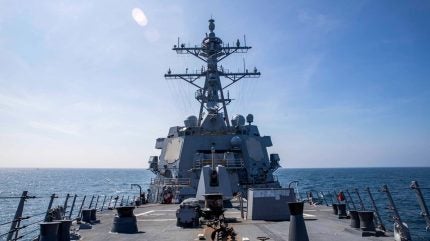
In a move that shows the delicate balance of power in the Indo-Pacific, the US Navy’s guided-missile destroyer USS Ralph Johnson (DDG 114) conducted a transit through the Taiwan Strait on August 22 2024.
While the US Navy framed the transit as a routine operation, adhering to the principles of freedom of navigation as per international law, the passage is anything but ordinary given the current context of heightened scrutiny on the Taiwan Strait. This waterway has evolved into a flashpoint between global powers as China’s naval claims are disputed.
The Taiwan Strait, a 110-mile-wide passage separating Taiwan from mainland China, has seen increased military activity in recent years.
China has sent fighter jets, aircraft carriers, and bombers over and around the strait as shows of force, and the People’s Liberation Army has persistently developed and deployed modern military competencies for a possible military campaign against Taiwan, as highlighted by GlobalData’s “Taiwan Defense Market 2024-2029” report.
China’s naval claims of sovereignty over Taiwan have been met with consistent pushback from the United States, which, though not officially recognising Taiwan as an independent state, remains its supporter.
Tensions between China and the US have escalated, particularly following recent US arms sales to Taiwan, including loitering munitions and F-16 spare parts. China has responded by suspending arms control talks with the US, criticising these sales as undermining its core interests and exacerbating regional instability.
USS Ralph Johnson’s voyage through these contested waters demonstrates the United States’ determination to maintain a naval presence in the region, reaffirming its commitment to ensuring that international waters remain free and open to all.
In recent months, Beijing has ramped up its military presence in the South China Sea and near Taiwan, frequently conducting drills that simulate blockades and potential invasions.
On May 10, 2024, the USS Halsey (DDG 97) also operated a Freedom of Navigation operation through the Taiwan Strait. For China, these transits challenge its assertions of sovereignty over Taiwan.
As the US continues to conduct such transits, it reinforces its alliances with other regional powers like Japan, South Korea, and Australia, who share concerns over China’s growing influence.
As the USS Ralph Johnson sails back into less contentious waters, its wake stirs up more than just the sea. With each passage, the question looms: How long can these “routine” transits continue before a new line is drawn in the sand, or rather, in the strait?



